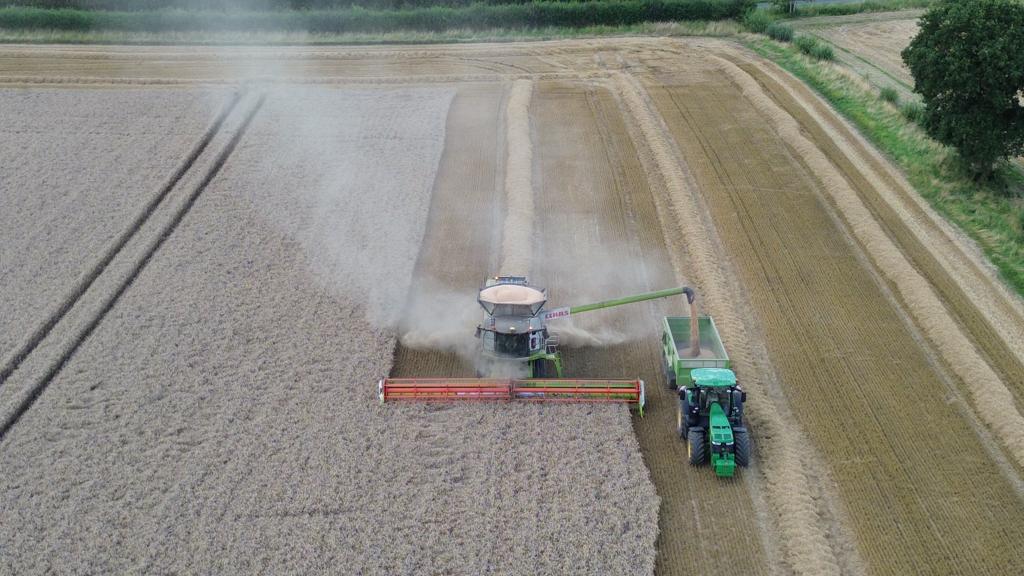Throughout this year, farmers have battled with the weather. Depending on the location, autumn was either too dry and grass weeds didn’t chit, or too wet to travel. In spring, wet weather dominated the early part of the season, only to turn dry when crops needed a little moisture. Now harvest is well under way, we catch up with some members of BASF’s Real Results Circle to find out what effect this difficult season has had on yields and crop quality.
Adrian Joynt, Shropshire
Adrian manages over 1295ha at the Apley Estate in Shropshire. He has 500 head of beef cattle grazing permanent pasture, and approximately 750ha of combinable cropping.
“Harvest is stop-start, with an emphasis on the ‘stop’. That said, we’ve probably harvested 40% of our total area,” he explains.
“We’re currently harvesting the wheat. The lighter land hasn’t done as well, but any soils that held onto a little moisture are doing ok.
“The winter barley was above average at 8.25t/ha. But that figure disguises the variation – we’d anything from 5t/ha on the very light land to 9.5t/ha for the best crops. It’s a pattern that is mirrored across the acreage.
Having had to redrill nearly a third of the oilseed rape (OSR) due to the dry conditions and cabbage stem flea beetle damage, Adrian is pleased to be approaching the end of its harvest with average yields.
“We‘re about a third of the way through the wheat. Spring barley is almost ready to harvest. Then we’ve some spring and winter beans, which look a fair way off.
“While we’ve had a lot of rain, it came at the wrong time and has been too late for the crops. The very hot weather in May and very early June is what did the damage – we could see the crops burning up. It was frustrating because up until that point, they were full of potential.
“Disease pressure was certainly high but we used a more robust fungicide programme on the wheat and it has been effective.
“Our grass weed control hasn’t been as good as I would have liked. The dry autumn really didn’t help, and then when we were looking to get spring graminicides on in April, it was a bit too wet and the weeds got a bit too big.
“Thankfully, we’ve very little black-grass so we’re targeting our meadow grass problem and the growing issues of ryegrass and brome with our normal applications of Liberator (flufenacet and diflufenican) plus or minus pendimethalin in the autumn, followed by Broadway Star (pyroxsulam + florasulam) in the spring.
“Next year we are not likely to change anything on the crop protection front, though we’ve an additional block of land coming into the mix so the machinery will.”
Freya Morgan, North Bedfordshire
Freya is responsible for over 1,600ha across North Bedfordshire and into South Cambridgeshire along with her son Joshua who has recently joined the partnership.
“We’ve cut the winter oats, and the winter and spring barleys, as well as some of the wheat,” she says.
“The winter oats have been good with bushel weights over 55. The spring barley is looking to have done well in terms of their nitrogen levels. We’re waiting for a few more results, but they should all be good to go for malting.
“All the wheat that’s been cut so far has come in between 17% and 13.5% moisture, with bushel weights of high 70s and reasonable Hagberg numbers.
“So currently, yields are as expected with reasonable quality,” Freya surmises.
“We’ve had rain during harvest but missed the worst of it, meaning we’ve been able to get going quicker than those who are either north or south of us.”
Freya has drilled this year’s OSR but is strict about the parameters. “In my book, it has to go in with good soil contact and moisture before 12th August. This year’s crop has been rolled twice, slug pelleted and it’s now coming up.”
“Disease hasn’t been too bad this year,” she recalls. “We tend to consider the pressure within the context of the varieties that we grow – Siskin, Extase, Dawsum and Skyscraper. We’d a robust fungicide programme which included tebuconazole + Elatus Plus (benzovindiflupyr), Revysol plus Xemium and another application of tebuconazole – this year that strategy seems to have paid off.”
“We don’t tend to drill too early, starting in mid-October but last autumn we’d no rain and so had no weed germination before drilling. The herbicides worked well but we do have odd bits of black-grass – predominantly in those areas which lie wet for a period after heavy rainfall.
“This year we used Avadex (triallate) – granular and liquid – can’t see any difference between them. Then we went in with Proclus (aclonifen) and Feud (diflufenican and flufenacet). Luximo was used where we felt it most needed and we will be using it more next year where we’ve bad patches in crops.”
David Fuller-Shapcott, Scottish borders
David’s 369ha mixed farm lies in the heart of the Scottish borders on predominantly heavy clay loam soils.
“The winter barley has been harvested but none of the other crops are ready yet,” he says. “That’s fairly usual for us, September is our main month for harvest.”
“Unfortunately, two and a half weeks of heavy rain has meant the winter barley brackled heavily and there were an awful lot of un-thrashed heads sitting on the floor. From an anticipated yield of 3t/ac, we harvested 2t/ac – it‘s quite a serious loss.”
David can’t remember a more difficult season for timing of applications and says it’s been a constant battle with the weather.
“It all started in the autumn when it was too wet to travel, roll and apply herbicides. As a result, early 2023 was extremely busy with these jobs, on top of the usual spring ones.
“Having not applied much fertiliser early in the year, disease pressure wasn’t too high. We didn’t have time to do a T0 but fortunately it doesn’t look to have had a negative effect on yields.
“We grow two spring crops – oats and barley. With spring being very late, the barley wasn’t drilled until April and is still very green at the moment.
“Overall, I’m confident that it’ll come good, it’s just we’re not quite there yet!”

